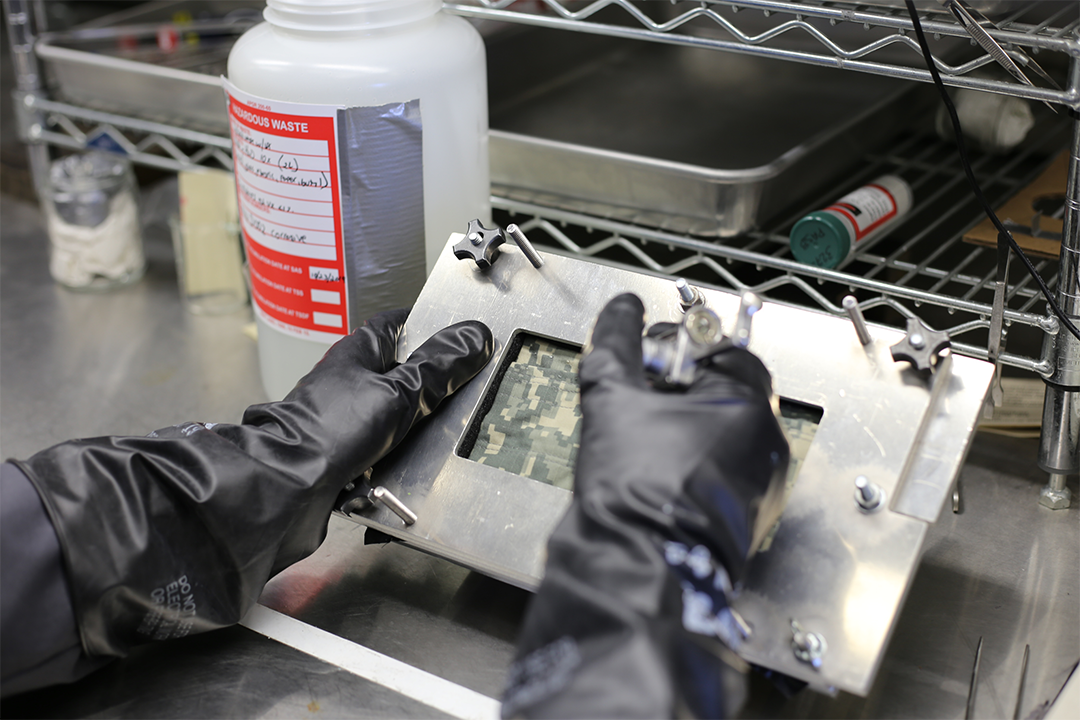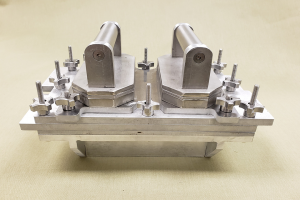// NEWS RELEASE
New Device Checks for Leaks around Zippers, Seams
More effective testing of protective gear increases Soldier safety
CCDC Chemical Biological Center Public Affairs | April 16th, 2020
New Device Checks for Leaks around Zippers, Seams
More effective testing of protective gear increases Soldier safety
DEVCOM CBC Public AffairsApril 16th, 2020

Chris Steinbach places agent onto material as part of initial testing to demonstrate that the test cell does not leak around the edges of a zipper.
Aberdeen Proving Ground, MD — Terrence D’Onofrio, Ph.D., has been a research chemist at the U.S. Army Combat Capabilities Development Command (CCDC) Chemical Biological Center for the past 17 years and prides himself on helping the warfighter. He does this through his knowledge of chemistry and his ability to shepherd complex projects from the laboratory to the testing community.
Recently, he led the U.S. involvement with the Porton Man full system, chemical protective ensemble research and test capability as an international partnership with the United Kingdom (UK). D’Onofrio helped transition Porton Man from a laboratory capability to be the first internationally accredited chem-bio test fixture. Now, D’Onofrio heads up a new project that tackles one of the biggest challenges warfighters face with their protective equipment – leaks at interfaces.
“We found some suit designs tested with Porton Man were great at protecting against agent contamination, except where the zipper and interfaces were, where it leaked like a sieve. That’s a problem,” D’Onofrio said.
D’Onofrio holds a patent on the Low Volatility Agent Permeation (LVAP) cell, a test method and device that enables researchers to quantify the amount of chemical agent that breaks through a fabric sample. The self-contained device works through a series of absorbent and protective material layers, along with a material that is exposed to chemical agent, to challenge the fabric’s effectiveness. A rubber O-ring sits above the material and below a weight that applies even pressure of one psi to ensure contact of all layers. The ring acts as a gasket to keep vapors from leaking. The entire apparatus is encased in a glass container.
“The LVAP completed an entire verification, validation and accreditation procedure,” D’Onofrio said. “We got it accredited through all the stakeholders in the test and evaluation community and now it is sanctioned as an official test method. We also made it a North Atlantic Treaty Organization standard and it’s now being used in other locations like the UK.”
While the LVAP is the standard for testing fabric against chemical weapon agents like VX, it has limitations. It can only test flat material samples.
“If you have a complicated feature like a seam or a zipper or Velcro, LVAP doesn’t work because that O‑ring cannot seal properly, and your background level of contamination is going to be huge, leading to false results,” D’Onofrio said.
Putting his head together with fellow chemist Christopher Steinbach and industrial engineer Doug Wilke, the three came up with a solution.
Through the Capability Analysis, Decision and Development (CADD) process the Chemical Biological Defense Enterprise identified the need for finding a way to test seams, zippers and other closures, and sought proposals. D’Onofrio and his team submitted a joint proposal with the West Desert Test Center and received funding in February 2019. By summer of that year, they had a working 3D-printed prototype and a patent pending on the new test cell.
The need to test seams and closures for leaks is a pressing practical requirement. “UIPE, Uniform Integrated Protective Ensemble family of systems is an acquisition program for the next generation chemical protective gear because the old Joint Service Lightweight Integrated Suit Technology ensemble is 20 to 30 years old,” D’Onofrio said. “They don’t make it anymore, and the DoD is finding newer, better materials and improved designs.”
The team designed multiple iterations of a new test cell and experimented with some scale models and agent to demonstrate that the guts of their design worked.
“There are two critical elements needed to make sure that this design is going to work properly,” D’Onofrio said. “First, we need to make sure it’s going to seal and that it doesn’t leak around the edges when you have a complex structure like a seam, closure or zipper. Second, you want to make sure that the contact and its function would be similar to the LVAP.”

The final prototype of the test cell is one of 30 to be produced and used.
D’Onofrio and his team started with a layer of butyl rubber, a chemically resistant material that serves as the foundation and a barrier against contaminating outside surfaces. The layering method is like the LVAP with a sorbent pad material on top of the rubber and a material sample with a seam, zipper or closure on top of that. The sorbent pad is analyzed later to measure the breakthrough. The next layer, however, is the most important piece of the design.
“We needed something that was going to seal and could handle that irregular material sample,” he said. “What we found was a soft nitrile foam that conforms and seals around the edges. It takes the place of the O-ring.”
Just like the LVAP, the 3D-printed prototype seam and closure test cell gets topped off with a weight that once again applies one psi, which is about the same pressure as a sturdy hand grip. What makes the new test cell different is the addition of a memory foam base. The researchers needed a way to apply weight to the top of the material sample and to have pressure come from under it so that the entire seam, zipper or closure has contact with the sorbent material beneath it.
“Memory foam is very soft and squishy,” D’Onofrio said. “We put it on a pedestal so when we have something complex, like a zipper that has shape and dimension, the foam fills in the negative space so all the bits of the zipper will be touched.”
Having a testing method for zippers, seams and other closures is a capability the Center wanted to develop for the Chemical Biological Defense Program. “Because seams and closures are a likely source of leaks, being able to quantify the level of breakthrough with confidence is important,” D’Onofrio said.
To prove that their prototype did not leak agent, D’Onofrio added a layer of aluminum foil above the butyl rubber layer so no agent could permeate the fabric material. “We knew that if we measured any chemical agent it was because it went around the edges and not through. It’s a way of measuring the background.” Because the agents are so toxic, even small background levels could exceed the requirement levels of the material. Demonstrating that the design could seal complex features was a critical piece of the form design review process.
The prototype went through a few more iterations where the team made the test cell more user friendly. They added big tabs so users can handle it easily even with gloves on. D’Onofrio credits his cross-functional team for coming up with practical innovations like the tabs.
“One of the benefits of working together is we are taking advantage of everyone’s individual skill sets,” he said. “We’ve brought together researchers, bench chemists, engineers and test operators. We need all of those elements together so that it works.”
Cooperation and collaboration include colleagues at the Center in Edgewood, Maryland, all the way to Dugway Proving Ground in Utah.
“This is a collaborative project. It’s not just me. We have engineering design capabilities within the Respiratory Protection Branch. It is also with the Engineering Directorate because they have the infrastructure to conduct more research testing and evaluation on materials with chemical agent. We’re also partnered with West Desert Test Center out of Dugway. So, we’re all in this together as a community,” D’Onofrio said.
D’Onofrio said the partnership with Dugway helps to ensure that whatever his team develops here, the Dugway team will be able to use there since they are the Major Range Test Facility Base charged with testing and evaluating projects like the seam and closure test cell.
“We develop it, we transition it and we partner with them so that we are working simultaneously in both labs. We have weekly telecoms and they are going to send people here to be cross-trained. We are also going to send our people over there to observe,” he said.
As D’Onofrio and his team continue to meet milestones, Dugway will manufacture 30 of the final renditions of the seam and closure test cell which will be made of aluminum and stainless steel, allowing for improved consistency and durability for upcoming rigorous testing. The new version includes weights with self-aligning features that provide reproducible placement of the weight on the rest of the test cell. The West Desert Test Center at Dugway will use half of the test cells and the remaining cells will come to the Center. The two facilities will conduct a series of verification and validation tests to enable transition of this capability from the science and technology community to the test and evaluation community.
D’Onofrio is pleased with the progress the team has made. “UIPE needs this for testing as part of the acquisition program,” he said. “This needs to be verified, validated and accredited by third quarter 2021. We only received the funding a year ago. Within that year, we got the design approved and partnered with Dugway to make them. Now, we have to test these to make sure they work properly and that the community will have confidence in the data.”
The U.S. Army Combat Capabilities Development Command (DEVCOM) leads in the discovery, development and delivery of technology-based capabilities to enable Soldiers to win our nation’s wars and come home safely. DEVCOM is a major subordinate command of the U.S. Army Futures Command. The DEVCOM Chemical Biological Center is the Army’s principal research and development center for chemical and biological defense technology, engineering and field operations. The DEVCOM Chemical Biological Center is headquartered at Aberdeen Proving Ground, Maryland.
